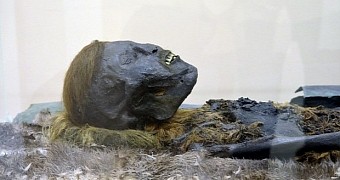While exploring a site in Siberia, not far from the Arctic Circle, archaeologists stumbled upon a coffin made of birch bark. The casket, shown in the video below, is estimated to date back to around the 12th or maybe the 13th century.
Although they have not yet opened it to have a look inside, researchers believe that it contains a mummy. Judging by its size, the mummy is most likely that of a child or a teenager.
The coffin is more like a cocoon, really
The birch bark coffin was recovered from the site of a village belonging to a lost civilization that once populated this remote corner of the world. It measures about 1.3 meters (4.2 feet) in length and 0.3 meters (0.9 feet) across at its widest point.
Having examined it, archaeologists found that the birch bark covers a sheet of metal, most likely copper. Together, the metal and the birch bark form a cocoon of sorts around the mummified body that scientists suspect is hidden inside the casket.
If the centuries-old coffin really does hide the body of a child or a teenager, chances are these human remains were not preserved on purpose but mummified naturally after having been buried in the Siberian permafrost, researchers say.
Once pulled from the ground, the casket was sent to the town of Salekhard and is now kept in a special freezer. In the weeks to come, the archaeologists who found it will more closely examine it and try to figure out whether it does, in fact, hide a mummy.
Why are they so sure there is a body inside?
For starters, it doesn't really make sense for anyone to have gone through the trouble of burying an empty casket. Then, it appears that, in recent years, several other coffins of this kind have been recovered from the same site, and when opened, they were all found to contain mummified bodies.
Hence, it makes sense to assume that this newly discovered birch bark casket also contains human remains. Whom exactly the remains belong to remains to be seen.
Interestingly, specialists say that, like the one they believe is lying in the latest coffin recovered from this site, all the other mummies found over the years in the area were nature-made.
“It was a combination of factors: the bodies were overlain with copper sheets, parts of copper kettles, and together with the permafrost, this it gave the preserving effect,” Alexander Gusev of the Research Center for the Study of the Arctic said in an interview, as cited by Archaeology.
Apart from mummified bodies, this archaeological site in Siberia has until now produced artifacts such as bear, reindeer or beaver furs, bronze bowls, a hatchet and a knife both made of iron, and a silver medallion.

 14 DAY TRIAL //
14 DAY TRIAL // 